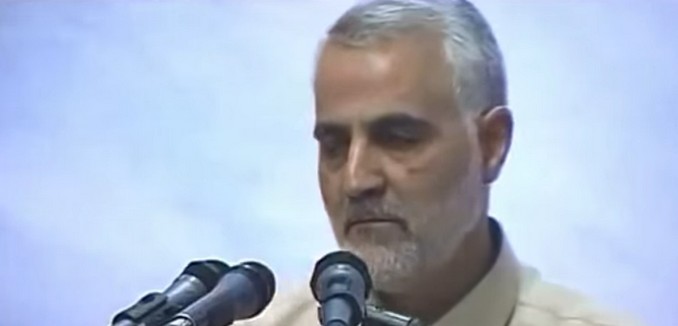Pictures of a lead Iranian military figure reportedly in Iraq’s Anbar province have raised concerns over the level of Iran’s involvement in Iraq, according to a report in the Long War Journal Monday. American military and intelligence officials indicated that Islamic Revolutionary Guard Corps (IRGC) Qods Force General Qassem Suleimani was recently Anbar, where Iraqi forces were recently chased from the city of Ramadi by the Islamic State of Iraq and Syria (ISIS).
The Long War Journal cannot independently verify the authenticity of the photographs. However, US military and intelligence officials have told The Long War Journal that Soleimani was in Iraq visiting with Shiite militias and commanders over the past several days.
In one grainy photograph, which is said to be from Iraq’s Anbar province, Soleimani is photographed in the desert with a group of Iraqis dressed in military fatigues. In another photograph, Soleimani is standing outside of a Toyota Hi-Lux reviewing a map with other men. The faces of the men are blurred.
According to the Long War Journal, Suleimani was also photographed in Baghdad meeting with two militia leaders—Popular Mobilization Committee chief Abu Mahdi al Muhandis, and Imam Ali Brigade leader Shebl al Zaydi. The Long War Journal speculates that the likely reason for Suleimani to meet with Muhandis and Zaydi would be coordinate the Iraqi militias in an effort to retake Ramadi from ISIS. Muhandis was named as a Specially Designated Global Terrorist by the United States government in 2009.
Suleimani’s reported presence in Anbar, as well as the death in that country of Jassem Nouri, an IRGC commander, indicate a direct Iranian involvement in Iraq.
Soleimani’s meeting with militia commanders and battlefield visit in Anbar, Nouri’s death in Ramadi, and the participation of Hezbollah Brigades and the Imam Ali Brigade in the fighting near Ramadi contradicts claims by senior US officials that the Iranian-backed militias, or the so-called “extremist elements,” are not involved in the fighting in Anbar. In an interview with CBS News on May 29, General (retired) John Allen, the Special Presidential Envoy for the Global Coalition To Counter ISIL, or the Islamic State, claimed that the militias in the Popular Mobilization Committee “have been subordinated to the Iraqi higher military campaign or command” and are not associated with Iran.
The Washington Post reported over the weekend that Iranian-backed militias had taken the lead in the planned attempt to retake Ramadi from ISIS. Suleimani’s reported presence in the region is a further sign of the degree of influence Iran is exerting over its neighbor.
As former U.S. Army intelligence officer Michael Pregent recently wrote, the rise of ISIS has presented a pretext for Iran to be present in Iraq and Syria: “Iran needs the threat of ISIS and Sunni jihadist groups to stay in Syria and Iraq in order to become further entrenched in Damascus and Baghdad.”
[Photo: ali javid / YouTube ]




